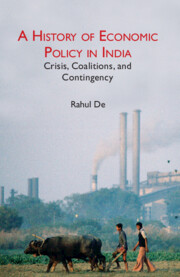Book contents
- Frontmatter
- Contents
- List of Figures and Tables
- Preface
- Acknowledgments
- List of Abbreviations
- Introduction
- 1 Colonialism and the Indian Economy
- 2 The Drive to Industrialize under Nehru's Leadership: 1950–66
- 3 The Turn to Populism under Indira Gandhi: 1967–79
- 4 The Early Liberalization Years: 1980–2003
- 5 Maturity of Reforms in the UPA Years: 2004–13
- 6 Reforms under the NDA Government: 2014–19
- Index
Preface
Published online by Cambridge University Press: 14 September 2023
- Frontmatter
- Contents
- List of Figures and Tables
- Preface
- Acknowledgments
- List of Abbreviations
- Introduction
- 1 Colonialism and the Indian Economy
- 2 The Drive to Industrialize under Nehru's Leadership: 1950–66
- 3 The Turn to Populism under Indira Gandhi: 1967–79
- 4 The Early Liberalization Years: 1980–2003
- 5 Maturity of Reforms in the UPA Years: 2004–13
- 6 Reforms under the NDA Government: 2014–19
- Index
Summary
This book was born out of more than a decade of research on understanding the contours of, and teaching a course on, the Indian economy for the last six years – more pertinently, a response to multiple discussions about the contemporary economy with people from a wide range of occupations from social activists, construction workers, shopkeepers, taxi drivers, and journalists; chance encounters with people in the upper management of multinational corporations; and the comments sections of discussions on Indian economic policy on social media. My interactions bore out two general observations: first, people are interested in understanding how the economy affects their lives – irrespective of the kind of work they do – and second, there is a serious dearth of accessible resources on the Indian economy.
In this book, I present an accessible history of economic policies in India from colonial to contemporary India. This book is meant to serve as a representative sample of important academic literature on the Indian economy organized thematically. It aims to provide a socio-historical narrative to explain economic policies in contemporary India. This work will be of particular value to readers who do not have a background in economics and might not have the time or inclination to read multiple works to understand a particular period or policy in Indian history. It can also serve as a complementary resource to a teacher as it provides a coherent and accessible narrative connecting different periods and different data sources, public documents, and academic literature that can be brought to the classroom.
I have been part of designing the economics curriculum at Azim Premji University (APU), Bengaluru. I believe that undergraduate economics education in India, especially in teaching economic theory, is abstract and focused on modelling and quantitative analysis; students are not well exposed to different trajectories of analysis within economics and complementary concepts provided by other disciplines like history, politics, and sociology. Other economics educators who I have interacted with have felt the same.* At APU, the economics curriculum has attempted to embed the historical, political, social, and intellectual within economic courses. The emphasis is on understanding theories within the context in which it was shaped. I start our Introduction to Economics class with the Industrial Revolution and explain how colonial intervention born out of the need for industrialization shaped the global capitalist economy.
- Type
- Chapter
- Information
- A History of Economic Policy in IndiaCrisis, Coalitions, and Contingency, pp. ix - xPublisher: Cambridge University PressPrint publication year: 2024

